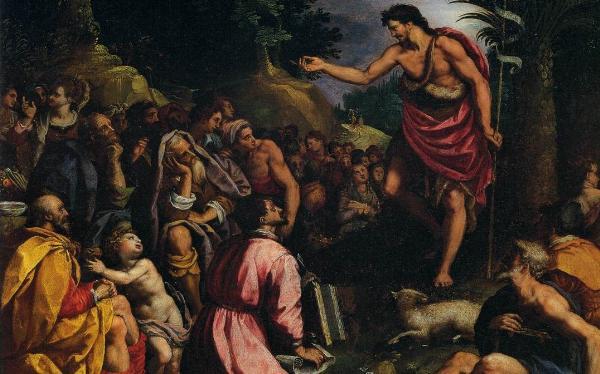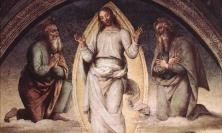On the second Sunday of Advent this year, we are introduced to John the Baptist in the gospel reading from Luke. Karen Eliasen approaches the reading with traditional artistic representations of Jesus and John the Baptist in mind: ‘Why does John the Baptist, depicted so often with a robust and masculine demeanour, not have what it takes to be a conquering hero of a king, but Jesus does?’
We encourage you to look at the readings for the Second Sunday of Advent alongside this article:
First Reading: Bar 5:1-9 Responsorial Psalm: Ps 25 Second Reading: Phil 1:3-6, 8-11 Gospel: Lk 3:1-6
The gospel reading on this second Sunday of Advent (Luke 3:1-6) places a voice crying out in the desert between a Caesar and the salvation of God. If we continue to read to the end of the third chapter in Luke from which the reading is taken, we see that the voice is really placed between Tiberius Caesar and the son of God, in this case Adam. Between the creation of Adam and the reign of Tiberius Caesar, a great deal has gone awry with the human world, the very context for the promise of the salvation of God. That is what the voice (or as The Message translation has it, the ‘thunder in the desert!’) delivers, the promise of salvation. But the voice, the thunder, delivering the promise is not the salvation itself; someone else’s voice is, and it makes me wonder about the difference between John the Baptist and Jesus.
I wonder about that because John the Baptist has always had a beguiling effect on me. Most often depicted in art as unruly-haired, sinewy and strong, John the Baptist strikes me as possessing something quintessentially masculine in a way that Jesus does not quite do, at least not in art. Behold almost any icon of the two in the Jordan, and be not in doubt about who is who: Jesus the meek and mild in the crossed-arms pose of his conceiving mother, and John the strong and steady in baptising action. It is a difference in concrete sturdiness that also tends to emerge in paintings of Mary with the two as small children. Yet it is Jesus and not John who endeavours to carry out that most masculine of projects, conquest. ‘It is my will,’ says the eternal King in the words of Saint Ignatius, ‘to conquer the whole world and every enemy.’ This is of course another way of expressing what the voice in the desert cries out, ‘and all flesh shall see the salvation of God’;so if the one whose advent we are acclaiming these days is destined for a universally conquering kingship of the kind that brings about the salvation of God (a king who needless to say is not another Tiberius Caesar), what does it take to live out such a destiny? The plot that moves from Christmas to Christ the King, celebrated at the end of the liturgical year, has as its hero Jesus, not John the Baptist. Why does John the Baptist, depicted so often with a robust and masculine demeanour, not have what it takes to be a conquering hero of a king, but Jesus does?
‘Masculine’, and soon to come, ‘feminine’: I know that here I need to remind myself of two bits of Scripture within which to hold these two adjectives and all the cultural and psychological baggage that weigh them down. The first text is from Genesis: ‘in the image of God he created him, male and female he created them.’ The second text is from Galatians: ‘there can be neither male nor female – for you are all one in Christ Jesus.’ Noble, Godly ideals – and I certainly accept them as such; but the reality of our fallen world, the one that ‘shall see the salvation of God’, is that it is both in practice and in imagination deeply sexed. I am part of that world, and I know I am when I look at pictures of John the Baptist and Jesus and respond to the conventional masculinity of the one and the lack thereof of the other. Being the acculturated creature that I am, I find myself again and again reacting with grumpy dissatisfaction to images of Jesus in art that explicitly undermine his assertive masculinity in a way the gospel texts themselves do not. I do not doubt that the femininity so many artists lather on Jesus in their work is meant to remind us of the consoling attributes of Jesus, as opposed to his conquering attributes. So parodying Professor Higgins’ complaint in My Fair Lady I want to ask not, ‘why can’t a woman be more like a man’, but why can’t Jesus be more like John the Baptist? (I am not oblivious to the implications, then, of the last line of Professor Higgins’ song, ‘why can’t a woman be more like me?’)
Religious writers in contrast to painters have not so readily shied away from applying explicit masculine attributes to Jesus, and perhaps none so more persistently than Saint Ignatius. The Ignatian spiritual worldview abounds with heroic fighting imagery as well as with kingly majesty jargon. Ignatius himself had a fighting background, and he drew heavily on it for his Spiritual Exercises. Not all of this masculine warrior imagery tends to sit well with modern Christians, and if some of this Ignatian imagery does not sit well with us moderns, then even less so does the Old Testament imagery in which a wrathful and vengeful warrior Yahweh seems to take centre stage at the expense of a consoling Yahweh. But in Ignatius’s writings and in the Old Testament alike, the warrior and the consoler are not mutually exclusive images of God. Nor are they unrelated to each other. Paradoxically they exist in one and the same God, and paradoxically we do not meet one without meeting the other. I suppose it is this paradox which seems to me to remain unacknowledged in all those depictions of an effete Jesus. But the question still remains why John the Baptist does not fit the kingly bill.
In looking back over the Old Testament traditions that John the Baptist arises out of, it is easy enough to recognise the burly and bearded and booming-voiced prophetic elements that are carried over into the New Testament. And it is easy to recognise the ritual priestly element of John, both through his ancestry and through his baptismal activity. What may not be so easy to recognise is the kingly element that John also carries over from the Old to the New Testament. The ultimate King, Yahweh the Creator, has subdued the forces of chaos to bring about order – order in the cosmos, order on earth, order in society, and order in people’s hearts. This kind of Creator is not so much the potter playfully moulding the clay as the warrior hero slaying the deep sea monster that threatens all life and becomes king. This is an Ancient Near East mythical scenario informing large tracts of the Genesis creation narratives, and it is the sort of role I can easily imagine John the Baptist symbolising. To relate John the Baptist directly to warriorship is not scripturally unwarranted: we are told elsewhere in Luke that John is to drink no wine, a characteristic of Nazirites who have been consecrated to God. The most famous example of such a consecration is Samson, strongman par excellence and a figure in a long line of hero-Judges that move the Israelites towards kingship. In the Old Testament, kingship is deeply intertwined with warriorship in a way our modern experiences of actual government or actual military can barely relate to. We relate imaginatively neither to those who rule us, nor to those who fight for us. Where we find ourselves far more readily aroused emotionally by the derring-dos of ‘warriors’ and ‘kings’ is in the sports arena and in the cinema.
This may be more a matter of form than of content. One of the highest-grossing film series of all time is The Lord of the Rings trilogy. In Tolkien’s story we are exposed to the king-themes familiar to us from Scripture, king-themes that include not just strength on the battlefield, but also powers of healing and renewal. This is true especially of the character most recognisable as a Christ-as-King type, Aragorn. Aragorn is a would-be king who is as capable of turning from the battlefield to tend to the wounded and dying as he is capable of doing the wounding and death-wielding on the battlefield. It is an understanding of the kingly office that Tolkien reiterates in his fantasy novels, that a king renews through his healing powers as well as frees those who are subject to him through his physical strength. Such a king embodies in himself a combination of feminine and masculine attributes, all the while remaining distinctly male. In the films, Aragorn is played by an actor (Viggo Mortensen) whose looks and demeanour capture an intriguing blend of masculinity and femininity even as it is unambiguous that he is a male and of a warrior physique. This kind of king maintains inklings of the wild John the Baptist and his vehemence at the injustices of the world, but moves beyond John the Baptist to tap into the life-bringing consoler image. But he does so without giving up the warrior image. For the trouble is, I realise, that although John the Baptist has not given up the warrior image, he has not taken on board the consoler image. Instead of consoling, he rants and raves: ‘Brood of vipers …’.
This does not compare well to the original context of the Isaiah passage (Isaiah 40) that John the Baptist so unashamedly identifies himself with, that thunder in the desert. Isaiah’s context, in contrast to John’s, is one describing a caring and consoling but also a strong and mighty God who will bring the long-suffering Israelites back home from the Exile. It is a context that includes images of God both as the shepherd, ‘gathering lambs in his arms, holding them against his breast’ (Is 40:11) as well as the warrior who, ‘reduces princes to nothing, the rulers of the world to mere emptiness’ (40:23). Both these poles are in the Isaiah passage presented as part and parcel of the continuum that is God the Creator of all that is. They are distinctly feminine and masculine images of God, equally present and necessary for the creative process, and not mutually exclusive in one and the same being; and they are certainly images of God we find elsewhere in the Old Testament. But it is a couple of chapters later in Isaiah that this intimate link between the masculine and the feminine aspects of God is dramatically emphasised as they are placed, extraordinarily, cheek by jowl. They are verses that often accompany me when I reflect on the many images of Jesus I so grumpily react against. For what can it really mean that in Christ there is neither male nor female, even as he is like us created in the image of God, male and female? Here are the two Isaiah verses (Isaiah 42:13-14, NJB):
Yahweh advances like a hero, like a warrior he arouses his fire. He shouts, he raises the war cry, he shows his might against his foes. From long ago I have been silent, I have kept quiet, held myself in check, groaning like a woman in labour, panting and gasping for air.
The death-wielding warrior and the birth-giving woman: these are arguably two clear and basic articulations of the Old Testament quintessential understandings of masculinity and femininity. They are ancient gender stereotypes that we seem never to be able to escape from in their divisiveness; yet here they are applied to God himself, here they are not divided but allied, forming the two inextricable strands of the one promised salvation awaiting us: death to the old and birth to the new. Which brings me to the here and now, waiting in the dark for the one born to be King, who as the son of God is the new human being, the new Adam who in himself is both male and female and yet as Christ is neither male nor female. Thereby hangs a salvation tale that crowns as universal King not an Adam, not a Tiberius Caesar, not a John the Baptist (for all the thunder in his voice), but a male human being who nonetheless embodies fully in himself the very best of what both the warrior and the consoler has to give, one who lives out both the masculine and the feminine with equal fervour in the service of the Kingdom: as warrior he conquers and as consoler he brings life. To which I can only with praise in my heart echo today’s Psalm response: ‘The Lord has done great things for us; we are filled with joy.’ (Psalm 125)
Karen Eliasen works in spirituality at Loyola Hall Jesuit Spirituality Centre, Rainhill.
‘John the Baptist in Advent’ by Peter Edmonds SJ on Thinking Faith Loyola Hall






